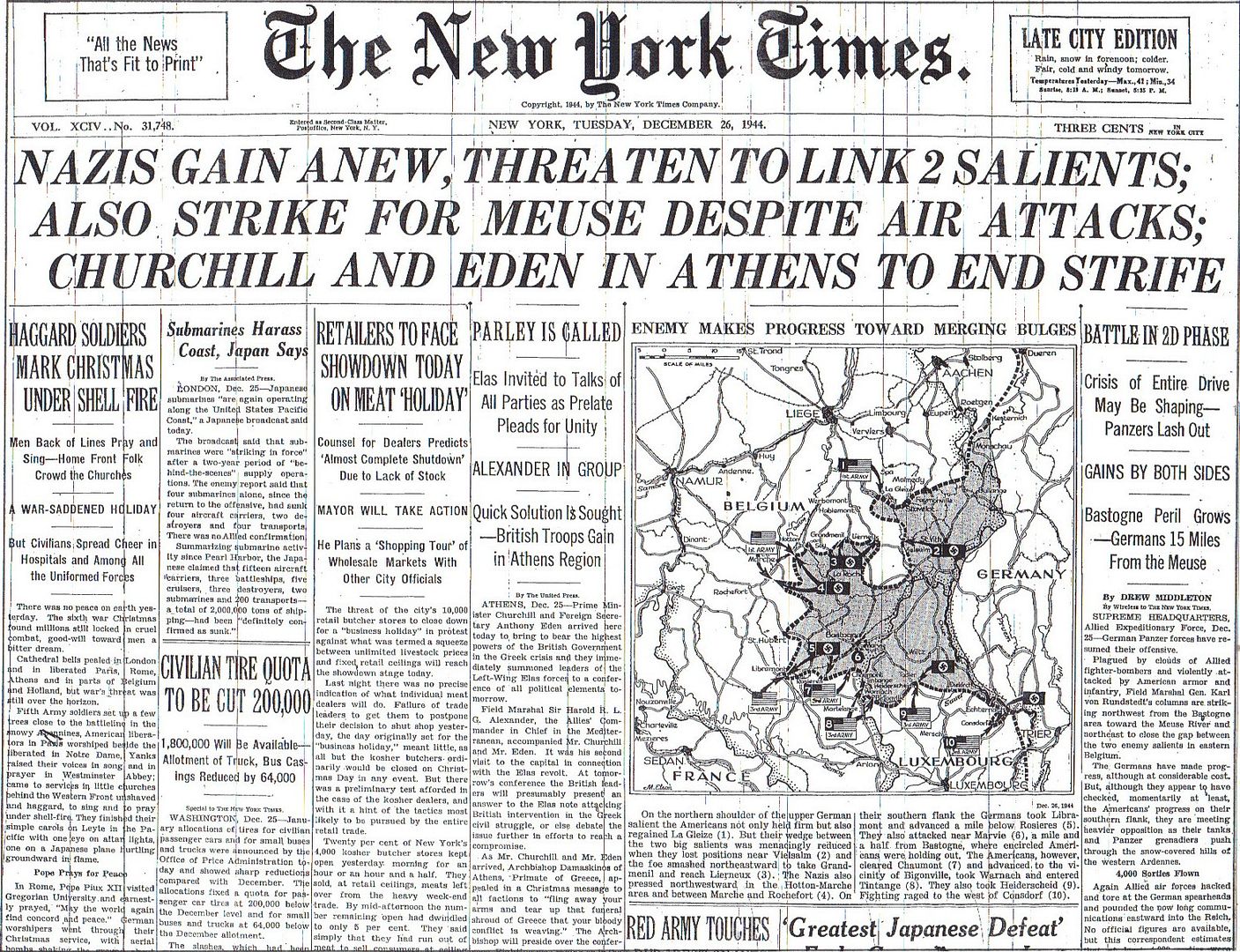
Posted on 12/26/2014 4:43:06 AM PST by Homer_J_Simpson

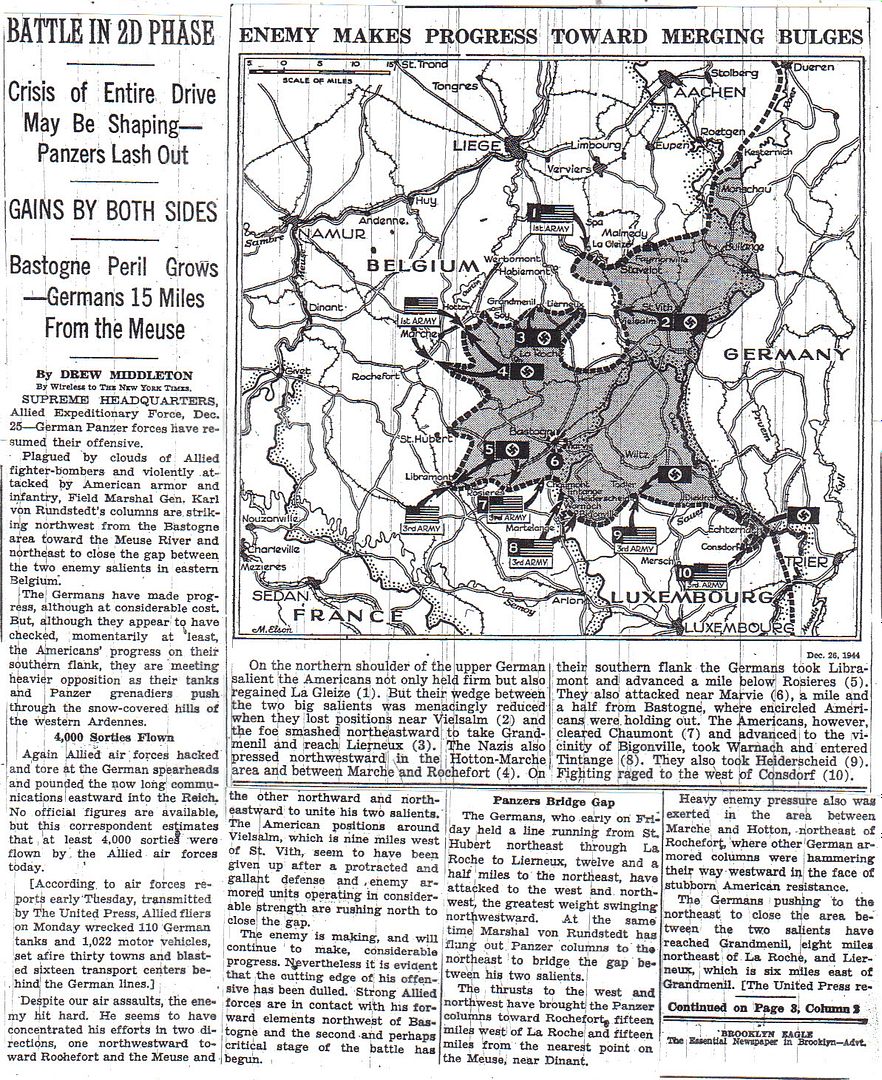
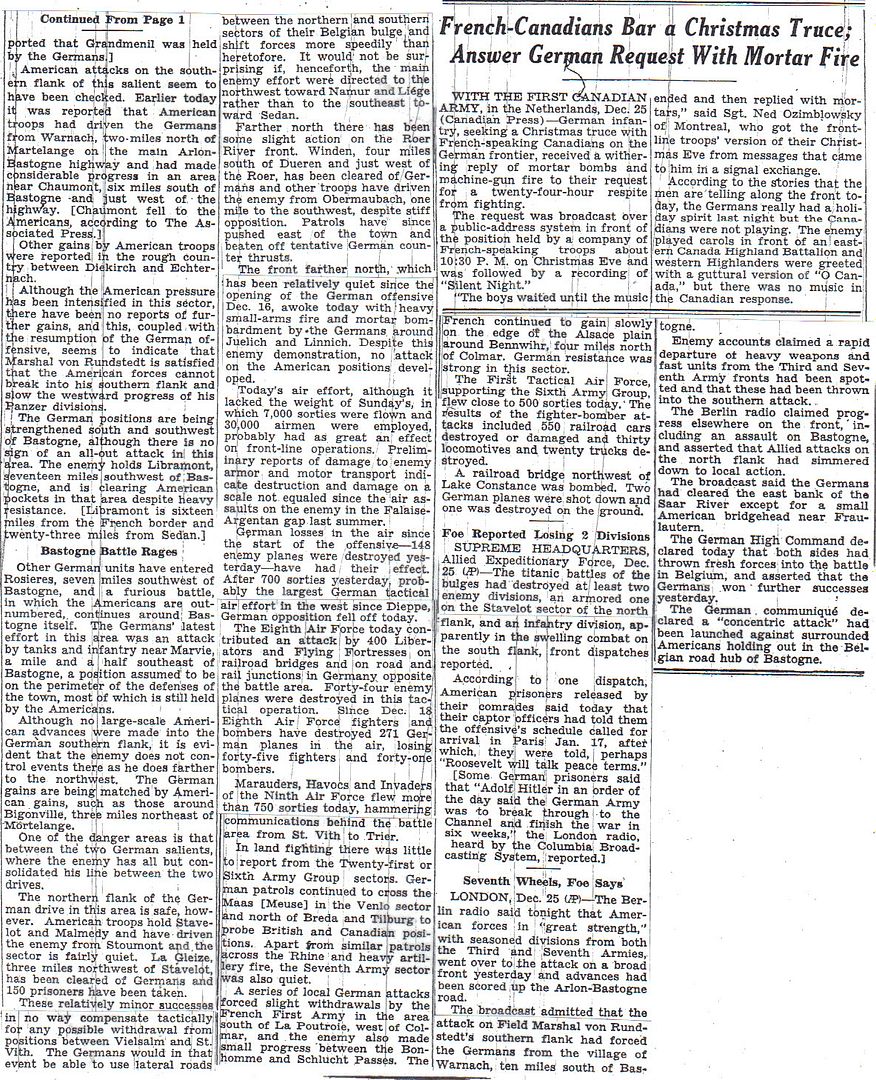


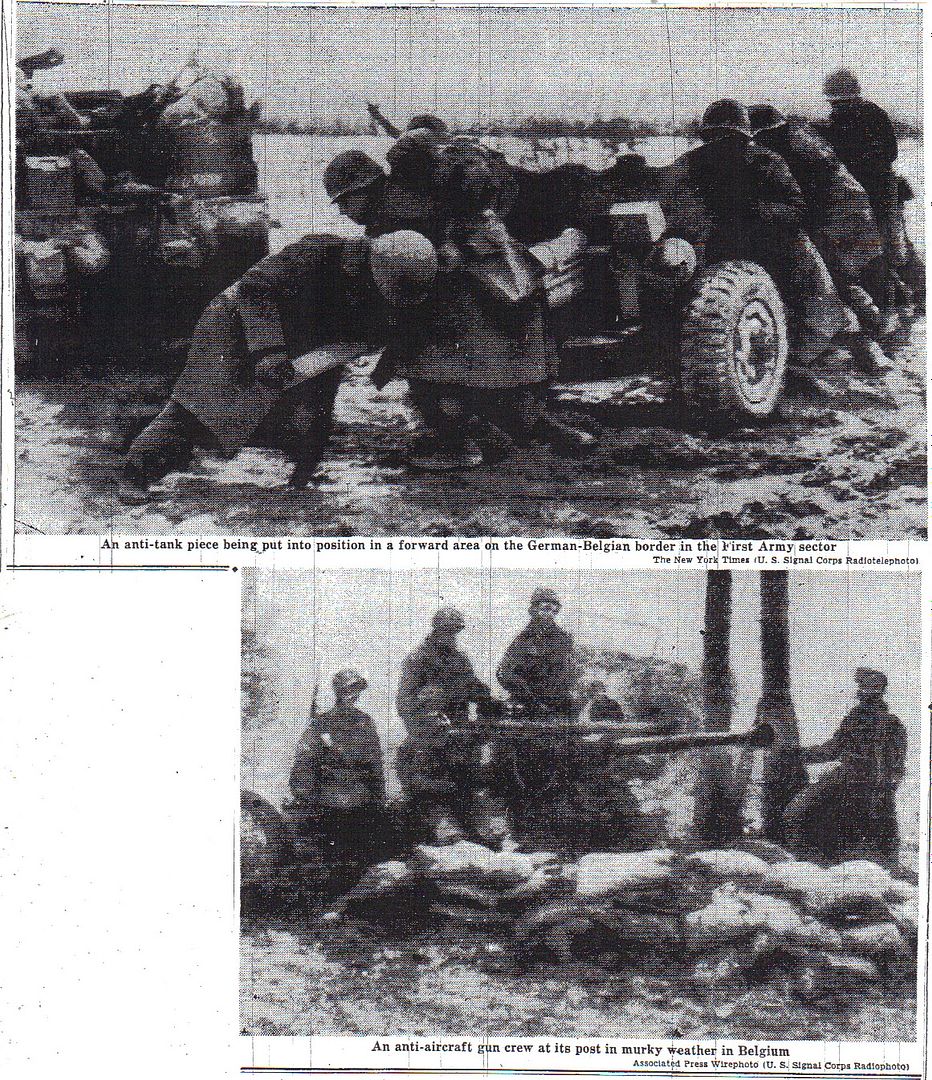

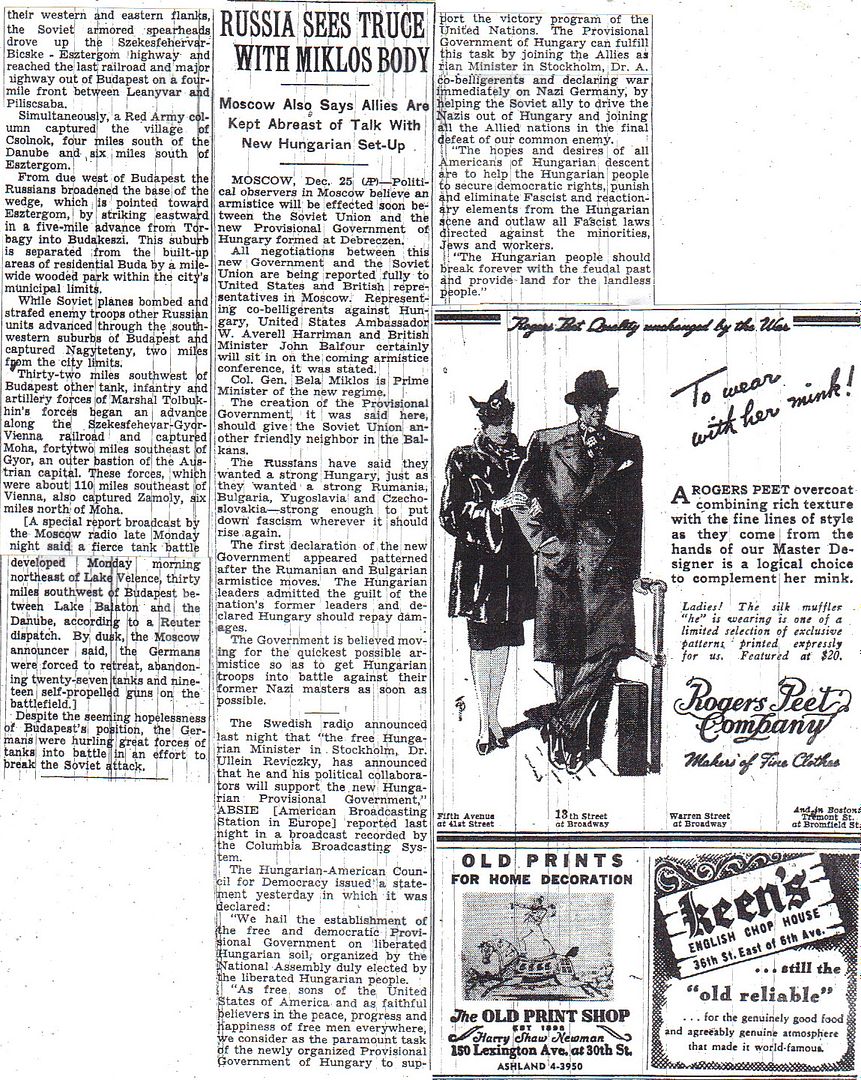
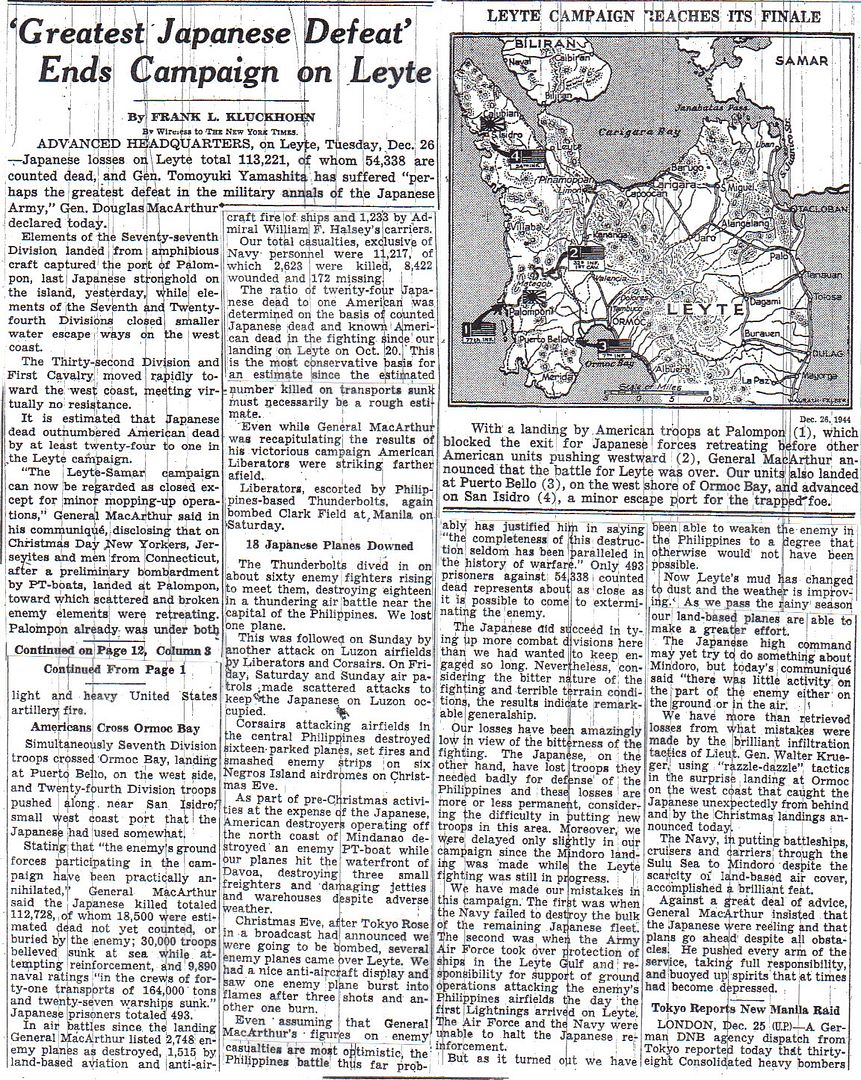
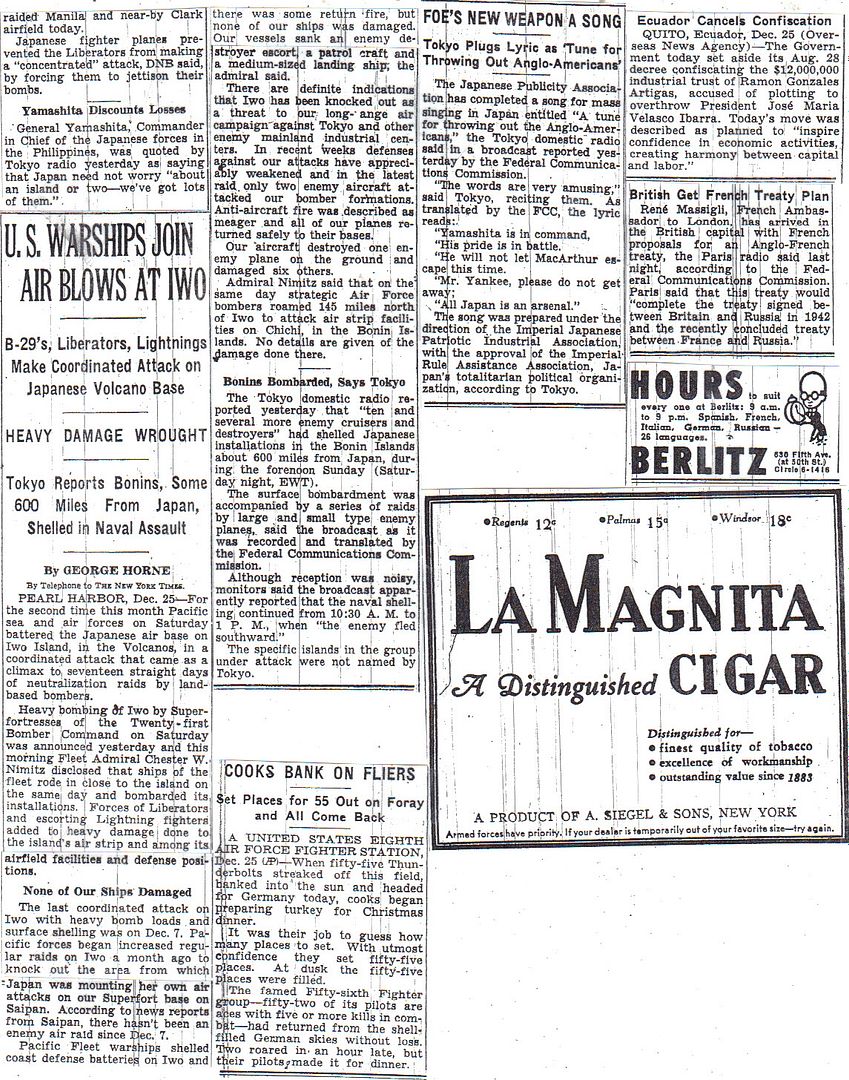
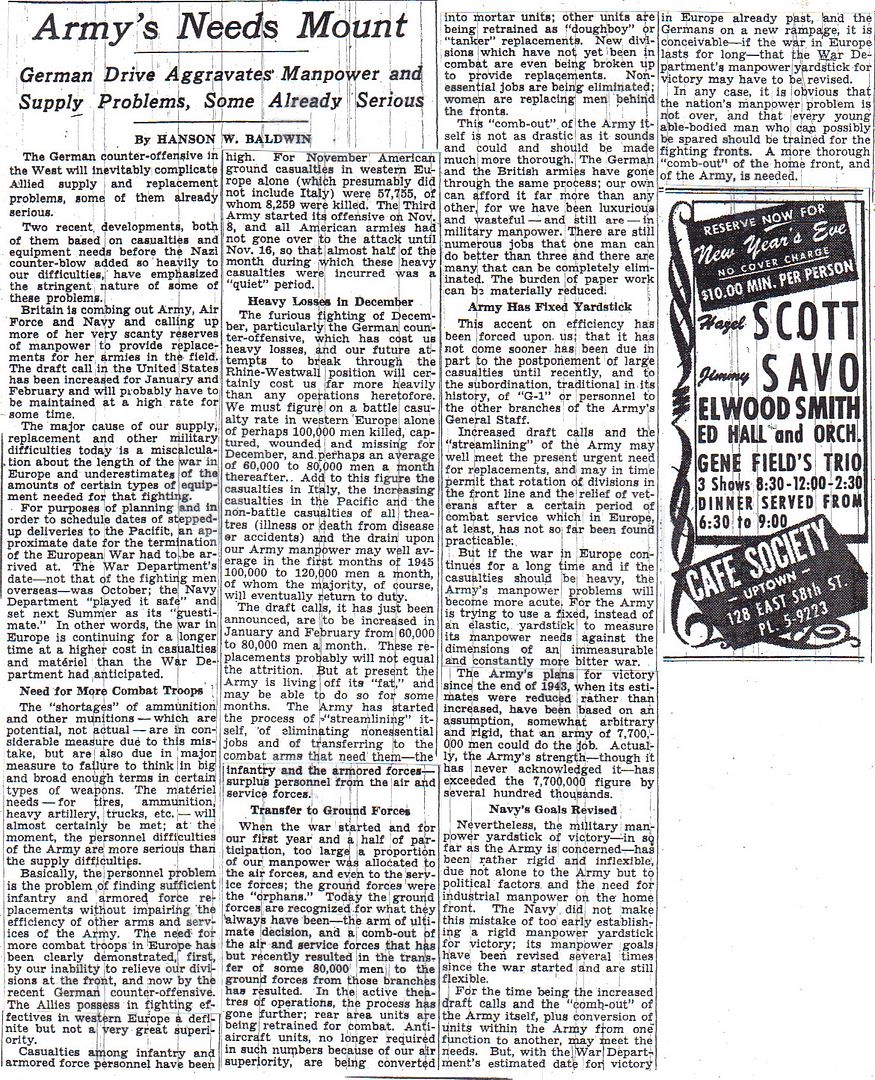
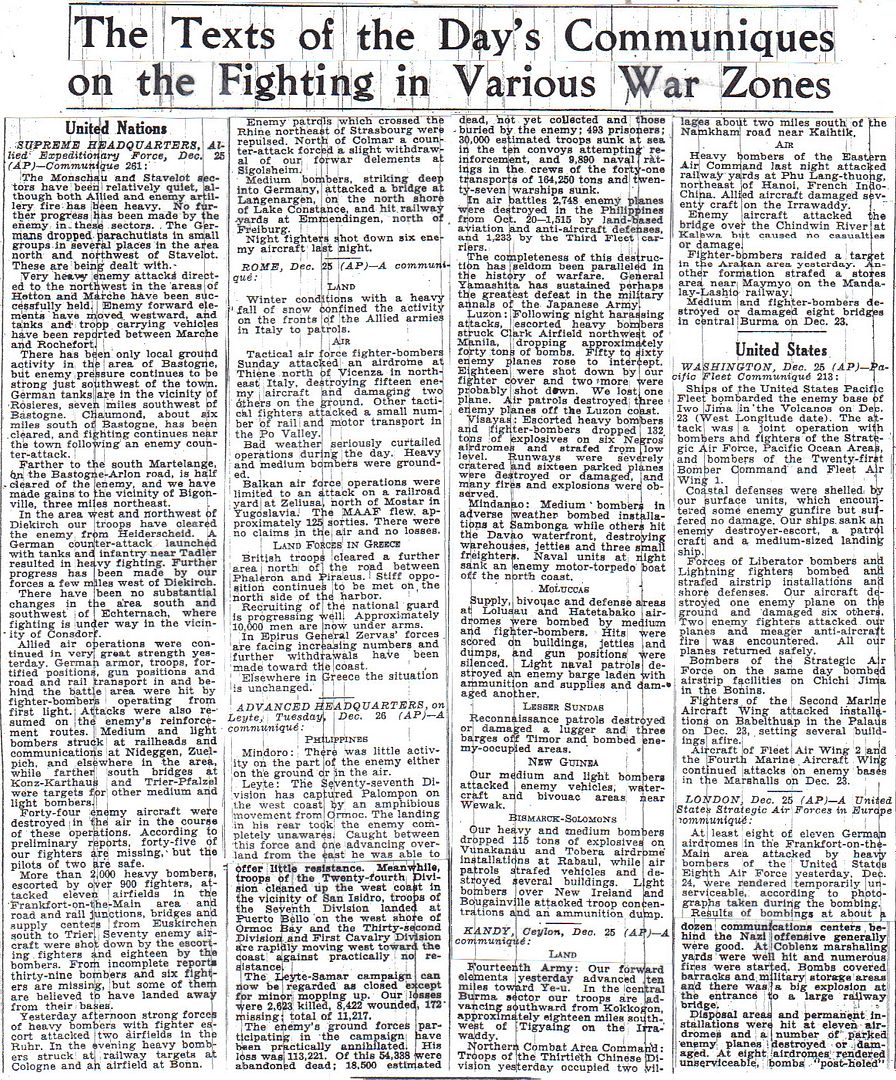
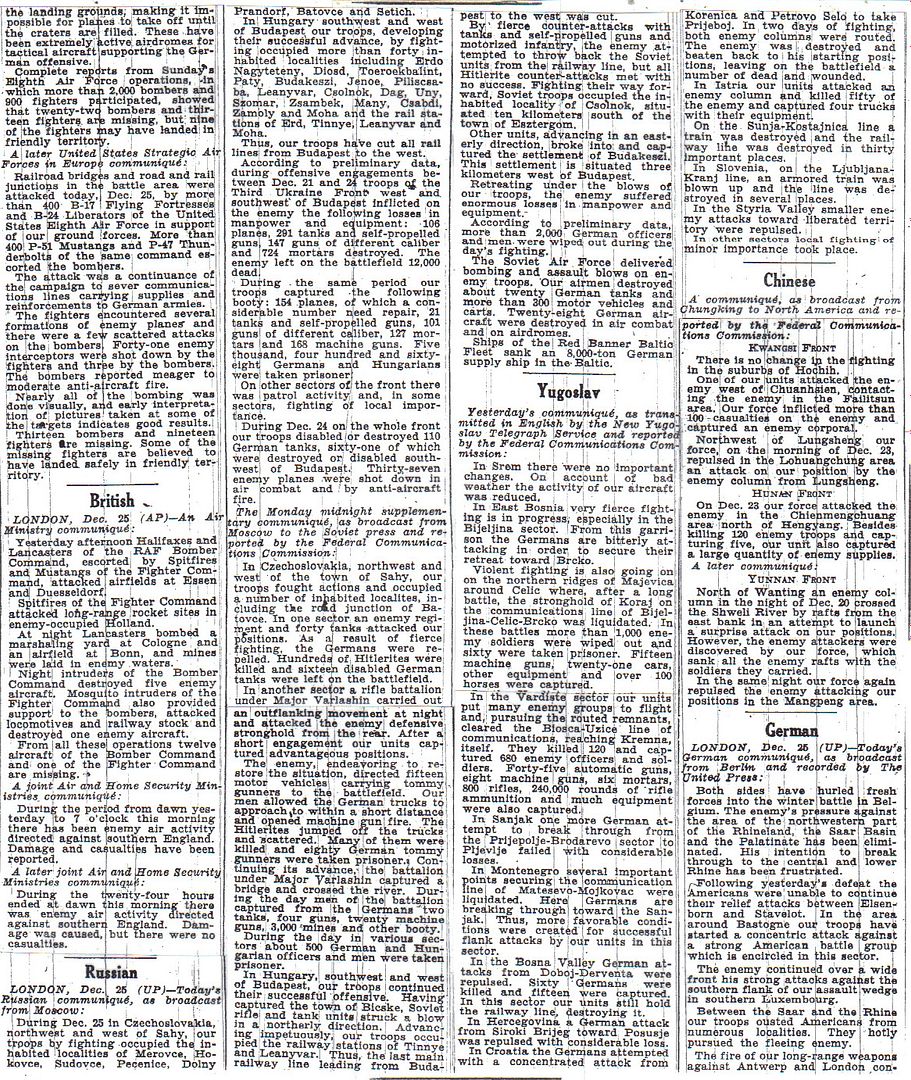
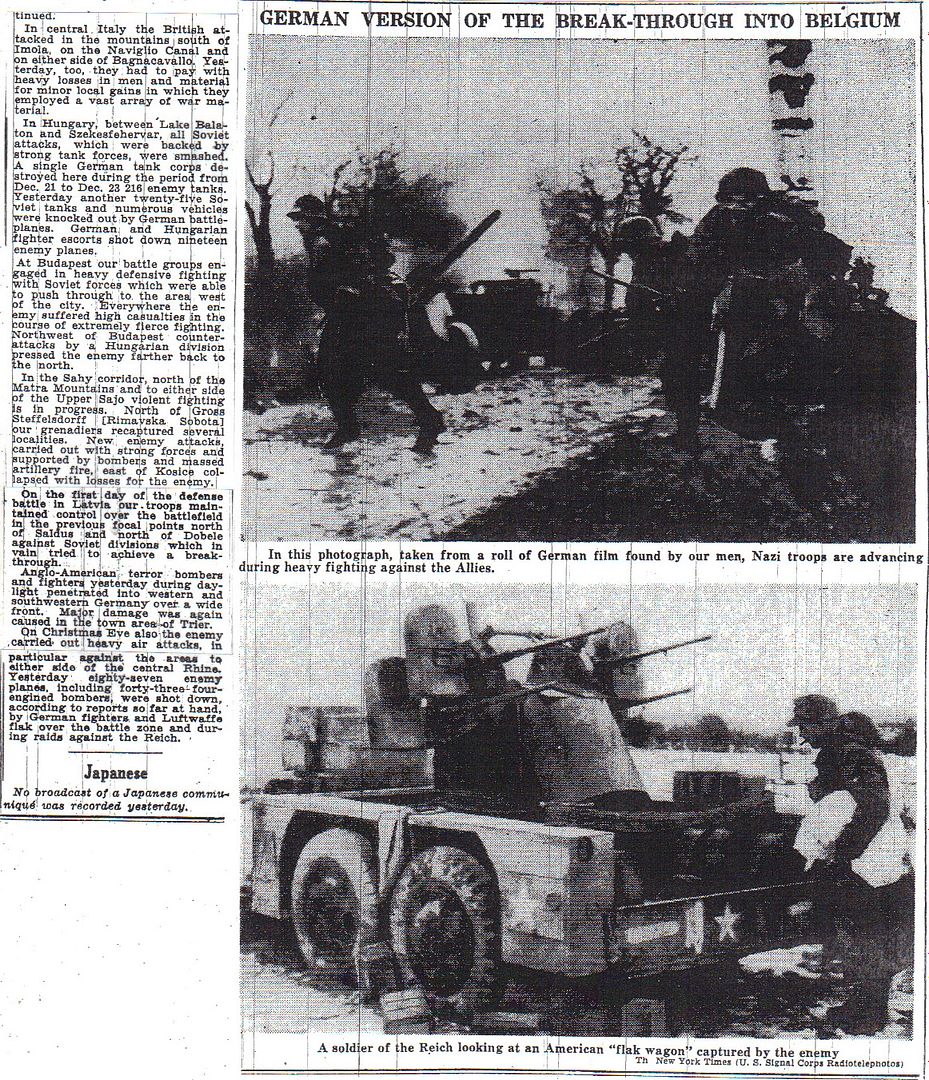
http://www.etherit.co.uk/month/11/26.htm
December 26th, 1944 (TUESDAY)
UNITED KINGDOM: A German A4 (V2) rocket hits the Prince of Wales pub in Mckenzie Road, Islington Borough, North London. Sixty eight people are killed.
The USAAF Eighth Air Force flies Mission 763: three B-17 Flying Fortresses and six B-24 Liberators drop leaflets in the Netherlands and Germany during the night of 26/27 December.
ENGLISH CHANNEL: German submarine U-486 torpedoes and sinks the British frigate HMS Capel [K 470, ex USN destroyer escort Wintle (DE 266)] in the English Channel about 12 nautical miles (23 kilometers) north of Cherbourg, France, in position 49.50N, 01.41W. The ship is hit by two G7s T5 electric Zaunkoning (Gnat) torpedoes. Seventy six of her crew go down with the ship.
BELGIUM: Bastogne is relieved by units from the US 4th Armored Division.
In the fast-gathering darkness a detachment of engineers manning the southern perimeter defences of Bastogne reported the approach of three armoured vehicles “believed friendly.” They were Shermans from Patton’s 4th Armoured Division, which had fought its way up through Luxembourg. Thus the German siege of the town, where five main roads meet, was lifted.
Lt-Gen Patton began his attack four days ago when he ordered the 4th Armored: “Drive like hell.” Favoured by the terrain, German parachute troops, fighting as infantry, stubbornly defended every village and patch of woodland, slowing the American armour. For the Americans inside Bastogne, it was touch-and-go whether they could hold out. Christmas Day began with a heavy overnight air bombardment; it was followed by an all-out Panzer attack directed at the western arc of the American defences. The battle lasted through the day, but the Panzers were badly mauled by the men of the 101st Airborne and a hastily-gathered assortment of reinforcements. As night fell it was apparent that the German assault had been broken.
This is almost certainly the turning point in the German’s Ardennes gamble. Von Manteuffel’s Panzers, unable to take Bastogne, had swept westwards towards the Meuse, following the Blitzkreig principle of keeping the armour moving. But 1940 is not to be replayed today.
For the past three days since the cloud lifted, the Germans have been mercilessly pounded from the air, and Major-General “Ligntning Joe” Collins’s armour and infantry, joined by British armour, have smashed the German spearhead at Celles. Today the Panzer remnants have begun pulling back.
Von Mantueffel is bitter at Hitler’s repeated failure to give him the reinforcements he needed. Only today was he told he could have the rest of the available reserves - and now they cannot be moved for lack of petrol. Yet had Peiper’s Kampgruppe pushed on through Stavelot ten days ago it could have taken a US fuel dump of over 2.5 million gallons . Peiper, cut off and short of supplied, told his men on Christmas Eve to head for home; fewer than 800 of the original force of 4,000 have reached safety.
Hitler was told today that any idea of capturing Antwerp, as he had talked of doing, must now be ruled out. Even the Meuse is beyond German grasp. Von Manteuffel telephoned Jodl at army HQ and said that the Allied were counter-attacking and he was pulling his men back from the Celles salient. Instantly, the order came down from the Führer halting the withdrawal. Von Rundstedt, nominally the overall commander of the Ardennes offensive, but profoundly sceptical of the operation, has offered his verdict on Hitler’s “No retreat” order: “This is Stalingrad Number Two.”
General der Infanterie Heinz Kokott, Commanding General 26 Volks Grenadier Division: “During the night of 25/26 December, the German encirclement forces conducted minor reorganizations and improvements of positions. The units were straightened out, small reserves were formed, lost contacts re-established, ammunition supplies restocked.” ...
“During the morning, Reconnaissance Battalion 26 believed to recognize enemy movements near Isle-la-Hesse. The battalions’s request for fire concentrations into that area was compiled with immediately.
“During the morning, the division received several disturbing reports through Rifle Regiment 39 as to there tense situation at the 5th Parachute Infantry Division, covering the division’s rear.
Detailed information, however, could not be obtained. Orientation by way of corps did mention hard fighting and strong enemy pressure at the 5th Parachute Infantry Division, but it was generally believed that it would be possible to keep the enemy from the encirclement front during 26 December.
“Towards noon, the fighting at Rifle Regiment 39 in front of Isle-le-Pre became somewhat more lively. Groups of tanks were recognized inside Isle-le-Pre and the enemy undertook several partial thrusts. Regiment 39 maintained that Sibert and Assenois were receiving artillery fire from the south.”
” ... Experience had shown that, during darkness and night, the enemy did not continue his attacks and that, as a rule, he would not resume them before 0900 or 1000 hours the following day. During that period there was generally nothing to be feared, plans could be made accordingly and - in this case - preparations. Furthermore, on 27 December the ‘Fuhrer Escort Brigade’ was to arrive.
” ... towards 1500 hours, a report came in via Rifle Regiment 39, from the division’s security screen ‘that elements of the 5th Parachute Infantry Division - forced by the enemy - had gone back to Sibert and via Hompre and that enemy tanks were attacking Clochimont.
“Shortly thereafter communications with Rifle Regiment 39 ceased to function. The division inquired with corps as to what was known about the situation at the 5th Parachute Infantry Division. Corps knew only about the fighting near Remichampagne and were surprised to hear that the front near Clochimont had been torn open.
“Towards 1600 hours, the division had ordered the 15th Panzer Grenadier Division to move several tanks (or armored vehicles), which in the meantime had arrived or had been repaired, to Regiment 39.
This group - about 4 to 6 vehicles with infantrymen and engineer as crews - was to set out as soon as the fighter-bombers would have disappeared (this was usually around 1600 - 1630 hours).
‘”Then before this small, final group of reinforcements had left, a call came through from the commander of Rifle Regiment 39 from his command post in the forest immediately northwest of Assenois. He reported:
“’Towards 1700 hours, while his regiment had been engaged in front of Isle-la-Hesse and at the northern edge of the Bois d’Hazy Forest, Assenois had been attacked by tanks from the direction of Clochimont. The weak local security detachment, together with supply personnel, some stray paratroopers and the staff of Regiment 39, had taken up the battle. Supported by artillery, the initial battle had been checked. The enemy had started a second attack, using smoke screens, phosphorus bullets and being well supported by artillery. He had penetrated the village; some elements had by-passed it to the east. Bitter street fighting had taken place in Assenois. Mines, anti-tank close combat weapons and anti-tank guns had put a number of enemy tanks and personnel carriers out of commission. Some of the crews had been wounded and taken prisoners. Despite some desperate, bloody resistance, the remnants of the enemy armored group had fought their way through Assenois. Nearly were 10 to 12 tanks in tight formation - firing from all their barrels - in a wild drive had broken from Assenois to Bastogne over and through the German encirclement front!’
Even though this had been a small armored group - the enemy had succeeded in his link up with the forces inside Bastogne! There remained no doubt that this steel spearhead would soon be followed by the impetus of strong, armored units.”
“The rear cover over the Bastogne encirclement ring had been split open in the southwest. As was found out through officers of reconnaissance detachments during the dark evening hours of 26 December, not a single man of the 5th Parachute Infantry Division was left between Salvacourt and Sibert.
“While Rifle Regiment 39 with its reduced forces had been able to close the gap of the initial armored enemy breakthrough, it was evident that in the long run the regiment would not be able to withstand an enemy pressure simultaneously from the north and south.
“The division could no longer supply any relief from its own resources. It had for a long time done more than could have been expected. With the best of intention, no additional forces could be scrapped together which could have been committed to strengthen the Assenois sector, not to mention for an attack against the enemy pouring into Bastogne (like through a corridor).
“Furthermore it had to be expected that the enemy in Bastogne - now that the ling up had been completed -, being encouraged and strengthened, would make an attempt to meet the armored forces in order to expand the corridor and to blast the ring in the south.
“It probably was merely a question of time as to when the enemy would begin a large-scale attack out of Bastogne to the north and northeast.
“The lack of forces on the German side was felt everywhere. In the north there was practically nothing, in the northeast a single regiment (Grenadier 78) was covering along a wide salient extending from Bastogne to beyond the Bastogne - Bras road. In the south there were the badly battered Regiments 901 and 39, at some points fighting in two directions, in the west (in addition to Reconnaissance Battalion 26) the remnants of the 15th Panzer Grenadier Division and Regiment 77 which, during the fighting of 25 December, had been reduced to a few fragmentary groups. The situation had reached the breaking point. The division, on the evening of 26 December, reported the situation to the corps, together with the developments likely to result from it. Corps could not be of any help. It had no resources. The situation at 2nd Panzer Division and Panzer Lehr Division - far removed from Bastogne - had deteriorated.”
“The offensive thrust of Sixth Panzer Army - activated for political reasons (!) - had been a total failure. “ ...
“On 26 December, the day when the 4th Armored Division broke through to join up with the 101st Airborne Division, the first part of the battle for Bastogne came to an end. It was one of the toughest and most bitter battles of this Second World War.
“Soldiers of the highest calibre had been facing each other. They fought without hate, strong and powerful, every man faithful to his duty, all for their country, instilled with the righteousness of their cause!
“27 December marked the beginning of the second phase of the battle for Bastogne - a chain of attempts (mostly with inadequate means and forces!) By the military/political authorities to exploit the operations ‘Ardennes Offensive’ at least for some political gains of prestige.” (Jay Stone)
In the U.S. First Army area, the army halts the German’s westward drive short of the Meuse River. The German supply lines are now overextended, and stalled armor becomes a lucrative target for aerial attacks. XVIII Corps (Airborne) maintains defensive positions and defeats German efforts to break through to the Meuse River. In the VII Corps area, the 3d Armored Division stabilizes its front except on the left, where contact has not yet been established with the 7th Armored Division; and seizes Grandmenil and the heights south of the Soy-Hotton road. The 84th Infantry Division reduces a German pocket between Verdenne and Bourdon and hurls back a German thrust toward Menil. The 2d Armored Division repels counterattacks in the Celles area and against Havrenne and Frandeux, inflicting heavy losses on the Germans.
In the U.S. Third Army area, armored units break through to Bastogne. In the III Corps area, forward tanks of Combat Command R, 4th Armored Division, push through Assenois to Bastogne, but vehicles are unable to follow. The 101st Airborne Division is temporarily attached to corps. Combat Command A, 9th Armored Division, is detached from the 10th Armored Division, XII Corps, and attached to 4th Armored Division for employment on the western flank.
USAAF Ninth Air Force bombers attack road junctions, rail bridges, rail head, communications and casual targets in the breakthrough area as the German’s westward drive ends short of the Maas River; fighters fly escort, armed reconnaissance, sweeps, and support the U.S. III and VIII Corps south of Bastogne, as the US 4th Armored Division breaks the ring around the city.
During the day, the weather at last improves and allows RAF Bomber Command to intervene in the Ardennes battle. Two hundred ninety four aircraft, 146 Lancasters, 136 Halifaxes and 12 Mosquitos, are dispatched to attack German troop positions near St Vith; 278 actually bomb. The bombing appears to be concentrated and accurate. Two Halifaxes are lost.
LUXEMBOURG: In the U.S. Third Army’s XII Corps area, the 26th Infantry Division closes along the Sauer River, winning Eschdorf in a lively battle, and begins crossing. The 80th Infantry Division, after clearing Scheidel, is halted in the Kehmen area and transferred in place to the XIl Corps; the intercorps boundary is adjusted accordingly. The 35th Infantry Division is attached to III Corps to assist in action against the southern flank of the Ardennes salient. In the XII Corps area, the 5th Infantry Division improves positions in the Echternach area and takes Berdorf. The 6th Armored Division, transferred to the corps from the XX Corps, moves into Luxembourg and relieves the 10th Armored Division. The latter passes to XX Corps control. The 109th Infantry Regiment reverts to the 28th Infantry Division (VIII Corps) from attachment to the 10th Armored Division.
FRANCE: Alsace: 7th US Army completed moving to defensive positions. Tanks and other armoured vehicles were given sand bag racks for a layer of extra protection in less-mobile defensive operations. VI Corps was spread dangerously thin with a make shift task force (Task Hudelston, 14th Armored Division) thrown together to cover ten miles of the most favourable defensive terrain.
German troop build up for “Operation Nordwind” continued with Hitler making the final decision for Army Group G to include: two SS Divisions (one Infantry and one Mountain Infantry, these two divisions were made up of young men raised and trained to be SS troopers) and six Volksgrenadier Divisions with one Armored Infantry and one Armored Division in Operational Reserve.
US 7th Army Forces now in defence were Five Infantry Divisions and one Armored division with One Infantry Division (-) and one Armored Division in reserve.
Troop strength for both forces was about even and included numerous new replacements. (Joe Brott)
At 1414, U-486 fired three Gnats at the 1st Escort Group on patrol off Cherbourg and observed hits after 1 minute 39 seconds and 1 minute 41 seconds and heard a third detonation after 7 minutes. Meyer claimed two destroyers sunk and a corvette damaged. In fact the frigates HMS Affleck and Capel (ex-USS Wintle) were hit. The latter sank and the other was towed to port, but declared a total loss. After the war the HMS Affleck returned to the US Navy in Britain, where she was sold on 24 Jan 1947 and served as mercantile hulk Nostra Senora de la Luz until 1970, when she was broken up.
In the U.S. Seventh Army area, the army finishes regrouping. XV Corps, holding the line from St Avold to Bitche, now consists of the 106th Cavalry Group (Mechanized) and the 103d, 44th, and 100th Infantry Divisions. VI Corps is disposed between Bitche and the Rhine River and contains Task Force Hudelson and 45th and 79th Infantry Divisions.
GERMANY: Berlin: Guderian convinced that the Ardennes offensive will end in failure, tries but fails to persuade Hitler to call it off.
U-2523 commissioned.
In U.S. Ninth Army’s XIX Corps area, the 8th Infantry Division clears Obermaubach and is working on the pocket to the south.
The USAAF Eighth Air Force flies Mission 762: Poor weather inhibits operations but 151 bombers and 336 fighters are dispatched to hit rail targets behind the Bulge; they claim 11-0-1 Luftwaffe aircraft; two fighters are lost. The targets are (numbers in parenthesis indicate number of aircraft bombing and number lost, e.g., 97-1):
- Marshalling yards: Niederlahnstein (35-0), Neuweid (12-0) and Andernach (9-0).
- Railroad bridges: Sinzig (35-0) and Neuweid (23-0).
- Railroad junctions: Sinzig (12-0).
Seventy P-51 Mustangs make a sweep in the Bonn area to support the bombers; they claim 3-0-0 aircraft; two P-51 Mustangs are lost.
USAAF Fifteenth Air Force B-17 Flying Fortresses attack two synthetic oil refineries (numbers in parenthesis indicate number of aircraft bombing and number lost, e.g., 97-1): the I.G. Farben South refinery at Blechhammer (121-9) and the Deschowitz refinery in Odertal (118-3).
BALTIC SEA: U-2342 sunk north of Swinemünde, in position 54.01.8N, 14.15.20E, by a mine. 7 dead, unknown number of survivors.
HUNGARY: The Soviet Third Ukrainian Front virtually closes the ring around Budapest; capturing the fortress city of Esztergom.
USAAF Fifteenth Air Force hit three targets as targets of opportunity: six bomb the marshalling yard at Kormend and one each bomb the marshalling yard at Cellodomolk and the city of Moson.
CZECHOSLOVAKIA: One USAAF Fifteenth Air Force bomber attacks the city of Podol as a target of opportunity.
POLAND: Ninety five USAAF Fifteenth Air Force B-24 Liberators bomb the I.G. Farben oil refinery at Oswiecim (part of the Auschwitz death camp) with the loss of 11 aircraft.
ITALY: Sommocolonia: First Lieutenant John R. Fox, Cannon Company, 366th Infantry Regiment, 92d Infantry Division, stays on in the town after German soldiers infiltrate the town. Calls down artillery fire upon his own position. This defeats the German attack, but results in the death of Lt. Fox. (MOH)
In the U.S. Fifth Army’s IV Corps area, the Germans begin a series of counterattacks against 92d Infantry Division positions astride the Serchio River, forcing a general withdrawal after outposts are driven back.
Good weather permits operations by the USAAF Twelfth Air Force in force for the first time in several days; during the day medium bombers concentrate on the Brenner Pass and hit Padua, San Ambrogio di Valpolicella, Ponte di Piave, Dolce, the Pordenone railroad bridge, and two dumps in the Bologna area. Fighter-bombers bomb railways, especially the Brenner line, bridges in the Po Valley, and northeastern Italy, support U.S. Fifth Army forces south of Bologna and in the Serchio River Valley where the Germans begin a series of counterattacks, and hit shipping at La Spezia and Genoa.
USAAF Fifteenth Air Force heavy bombers attack railroad targets. The targets are (numbers in parenthesis indicate number of aircraft bombing and number lost, e.g., 97-1):
- Railroad bridges: Ora (44-0), Mezza Corona (9-0), Rovereto (7-0) and Lavis (1-0).
- Railroad junction: Cavlese (1-0).
- Railroad viaduct: Aviso (26-1)
One other bomber attacks a highway as a target of opportunity.
During the day, 34 RAF bombers of No. 205 (Heavy Bomber) Group bomb the railroad bridge at Casarsa.
During the night of 26/27 December, USAAF Twelfth Air Force A-20 Havocs bomb pontoon bridges at Ficarolo, road bridges at Ostiglia and Castel Maggiore, San Benedetto Po crossing, Turin Airfield, and several Po Valley roads.
YUGOSLAVIA: During the day, 32 RAF bombers of No. 205 (Heavy Bomber) Group drop supplies to partisans.
CHINA: Major General Albert Wedemeyer, Commanding General U.S. China Theater of Operations and Chief of Staff to Chinese Generalissimo Chiang Kai-shek, meeting with Chiang Kai-shek, U.S. Ambassador Major General Patrick Hurley, and Chinese Minister for Foreign Affairs, T. V. Soong, proposes that the food, clothing, and pay of Chinese Army be improved. He also informs the Generalissimo that plans are being made for an offensive (Operation BETA) against Kweilin, Liuchow, and Canton.
Five USAAF Fourteenth Air Force B-25 Mitchells hit targets of opportunity in the Formosa Strait, in the Siang-Chiang Valley, and at Ikiawan and Changsha and 12 P-51 Mustangs attack the Tsinan Airfield.; 46 P-51 Mustangs, P-38 Lightnings, and P-40s hit railroad targets, shipping, storage and other targets of opportunity at or near Kinkiang, Anking, and Ka-chun, China.
BURMA: In the British Fourteenth Army’s XV Corps area, the Indian 25th Division reaches Foul Point, at the tip of the Mayu Peninsula, well ahead of the expected time. The Japanese decide to withdraw from Akyab.
Eight USAAF Tenth Air Force B-25 Mitchells knock out and damage bridges at Taunggon, Padan, and Kyaukhlebein; 34 P-47 Thunderbolts hit troop concentrations at Panghai, Mongyu, Na-hsang, Man Om, and Hpa-lin while eight others hit stores area and a distributing point at Hsenwi; 11 attack supplies at Pangpao, and two bomb rafts, boats, and landing points at the Myitson ferry. Four B-25 Mitchells fly offensive night reconnaissance against communications lines. .
Six USAAF Fourteenth Air Force B-25 Mitchells bomb Wan Lai-Kam and fighter-bombers hit targets of opportunity in the Mong Long Valley, and Man Pong.
THAILAND: USAAF Fourteenth Air Force fighter-bombers hit targets of opportunity at or near Lampang.
COMMONWEALTH OF THE PHILIPPINES: The US beachhead on Mindoro is bombarded by a Japanese naval force, of two cruisers and six destroyers, sailing from Indochina. A US PT boat sinks one destroyer. This is the last sortie by a Japanese naval force in the area of the Philippines.
In the U.S. Eighth Army’s X Corps area on Leyte, the 1st Cavalry and 32d Infantry Divisions continue west over rough terrain. The 34th Infantry Regiment, 24th Infantry Division, prepares to clear the northwestern part of the Leyte Peninsula. Companies F and G sail at 2300 hours through Biliran Strait to Gigantangan Island, where they spend the night. In the XXIV Corps area, the 77th Infantry Division remains in place in the Palompon sector.
USAAF Far East Air Forces B-24 Liberators bomb Clark Field on Luzon Island. On Mindanao Island, B-25 Mitchells hit Matina Airfield, shipping in the Davao River, and bomb nearby Samal Island while B-24s hit Libby airfield.
USAAF Fifth Air Force P-38 Lightning pilot Major Thomas B. McGuire, Jr., shoots down four Japanese “Zeke” fighters (Mitsubishi A6M, Navy Type 0 Carrier Fighters) over Manila, Luzon. McGuire has shot down seven “Zekes” in two days and he is nominated and later awarded the Medal of Honor for these actions. This brings his total victories to 38.
VOLCANO ISLAND: Thirteen USAAF Seventh Air Force B-24 Liberators based on Guam bomb Iwo Jima during the day. During the night of 26/27 December, two other B-24s bomb the island.
EAST INDIES: On Halmahera Island, USAAF Far East Air Forces (FEAF) B-25 Mitchells, B-24 Liberators, and fighter-bombers hit Galela, Lolobata, and Hate Tabako. Miscellaneous attacks by other FEAF aircraft are flown against targets in North Borneo, northeast Celebes, and Halmahera Islands. A B-24 Liberators sinks a Japanese cargo vessel off south coast of Boeroe Island.
MARCUS ISLAND: Three USAAF Seventh Air Force B-24 Liberators based in the Mariana Islands fly armed reconnaissance and bomb the island. Marcus Island is located in the North Pacific about 768 nautical miles (1 422 kilometers) west-northwest of Wake Island and is used as a refueling point for Japanese aircraft en route to the Central Pacific.
PACIFIC OCEAN: In the South China Sea, the Japanese “Intrusion Force” under Rear Admiral KIMURA Masanori, consisting of the heavy cruiser HIJMS Ashigara, light cruiser HIJMS Oyodo, three destroyers and three escort destroyers, approaches Mindoro Island, Philippine Islands, to bombard the beachhead. USAAF Far East Air Forces B-25 Mitchells, P-38 Lightnings, P-40s, and P-47 Thunderbolts and USN PB4Y Liberators and PBM Mariners successively attack the force. They damage heavy cruiser HIJMS Ashigara (near-misses), light cruiser HIJMS Oyodo, destroyers HIJMS Asashimo, Kiyoshimo, and Kasumi, and escort destroyers HIJMS Kaya and Kashi. KIMURA’s force carries out its bombardment mission, then encounters U.S. motor torpedo boats; PT-77 is damaged, probably accidentally bombed by friendly aircraft. Subsequently, PT-223 sinks the already damaged destroyer HIJMS Kiyoshimo off San Jose, Mindoro. The Japanese ships arrive off Mindoro and about 2300 hours begin bombarding the beachhead. (Ja ck McKillop)
SOUTH-WEST PACIFIC: Major Thomas B. McGuire (USAAF) flying a Lockheed P-38 shoots down four Mitsubishi A6M, Navy Type 0 Carrier Fighters (”Zeke”).
U.S.A.:
Minesweeper USS Disdain commissioned.
Destroyer USS Douglas H Fox commissioned.

The 'Cobra King' crew -- 1st Lt. Charles Boggess, Cpl. Milton Dickerman and Pvts. James G. Murphy, Hubert S. Smith and Harold Hafner -- pose for a celebratory photo in the vicinity of Bastogne, Belgium shortly after the tankers led the armor and infantry column that liberated the city in December 1944.
Cobra King' led 4th Armored Division column that relieved Bastogne during Battle of the Bulge
By Dave Melancon, U.S. Army Europe Public Affairs Office - February 25, 2009
VILSECK, Germany -- A World War II-era warrior with a storied past still stands guard over the back gate of Rose Barracks here.
That sentinel is a Sherman tank, nicknamed "Cobra King" by her first crew, that helped liberate occupied France, helped to relieve the embattled 101st Airborne Division at Bastogne, breached the Siegfried Line and battled its way through Germany into Czechoslovakia.
The 37th Tank Battalion, 4th Armored Division fought many hard-won battles in France, but Cobra King and its crew earned their place in U.S. Army history during the Battle of the Bulge.
One day after Christmas 1944, Cobra King - its nickname symbolic of the tank corps tradition of naming vehicles with the first letter of their companies' designations -- and its five-man crew from the 37th's Company C led a column of infantry and armor that relieved the encircled Soldiers of the 101st Airborne Division at Bastogne, Belgium.
On Dec. 24, 2008 - just two days shy of the 64th anniversary of its entry into Bastogne -- U.S. Army Europe historians announced that the tank's identity and lineage had been confirmed.
A German offensive, called "Watch on the Rhine," began Dec. 15, 1944 when the German 5th and 6th Panzer Armies pushed through U.S. lines along the German-Belgian border, headed for Antwerp. U.S. forces were pushed westward, but the 101st, held fast in Bastogne surrounded by the enemy.
The 4th, part of Gen. George S. Patton's 3rd Army, began its 19-hour, 150-mile race to rescue the 101st in Bastogne Dec. 18. The Germans continued their attack on the western side of the Bastogne perimeter Dec. 26 but the U.S. lines held firm.
Cobra King and its crew began their 5-mile final push into Bastogne through stiff German resistance, according to a January 1945 interview with Capt. Stedman Seny, the division assistant operations officer, on the division association's Web site.
The commanders of the 37th and the 53rd Armored Infantry Battalion, Lt. Cols. Creighton W. Abrams Jr. and George L. Jaques, were ordered to make a break for Bastogne, he said.
Race to Bastogne
Starting from assembly areas north of Arlon Dec. 22, the 4th's three combat commands, similar in size and organization to today's modular brigade combat teams, battled their way to Bastogne. The division sustained heavy losses along the way.
While preparing for their next push, Abrams and Jaques saw the sky filled with cargo planes dropping ammunition and supplies to the surrounded paratroopers. Abrams suggested they try a dash through the village of Assenois straight into Bastogne.
That afternoon division tankers took the high ground near the village of Clochimont, about five miles southwest of Bastogne, Seny said. According to his report, the 37th was down to 20 medium tanks and the 53rd was short about 230 men as the two units' C Companies set out. Cobra King, bumper number C-6, led the column of tanks and halftracks with 1st Lt. Charles P. Boggess of the 37th's Company C in its commander's seat.
According to reports, U.S. artillery rained 2,340 shells on enemy positions, tankers and infantrymen and showered the defending Germans with heavy machine gun fire as the column, in Seny's words, "highballed through Clochimont" toward Assenois, the last stop before Bastogne.
Thick woods concealed blockhouses defending the road beyond Assenois. Boggess's company had the job of plowing through those defenses without stopping. The companies that followed, supported by the 53rd, would mop up behind them.
After the first four U.S. tanks continued north through Assenois, the Germans detonated Teller mines behind them, knocking out a halftrack and wounding several infantrymen, Seny said.
"The Germans had these two little towns of Clochimont and Assenois on the secondary road we were using to get to Bastogne. Beyond Assenois, the road ran up a ridge through heavy woods. There were a lot of Germans there, too," Boggess said in a December 1949 article in European Stars and Stripes. "We were going through fast, all guns firing, straight up that road to bust through before they had time to get set."
"I used the 75 (mm main gun) like it was a machine gun," said gunner Cpl. Milton Dickerman. "(Loader Pvt. James G.) Murphy was plenty busy throwing in shells. We shot 21 rounds in a few minutes and I don't know how much machine gun stuff."
"We moved full speed, firing straight ahead, with the other tanks firing left and right. We weren't supposed to stop on the way, either," Boggess said in an interview with strictly-gi.com during the 40th anniversary commemoration of the battle in 1984.
North of Assenois, Boggess and crewmen Pvts. Hubert S. Smith, driver, bow machine gunner Harold Hafner, Murphy and Dickerman approached a team of combat engineers in U.S. uniforms assaulting a pillbox. Boggess, aware of reports of German soldiers masquerading as Americans, called out to the engineers' platoon leader, who identified the team as U.S. Soldiers.
"We then came across a large pillbox, which we at once destroyed," Boggess said. "There certainly was a lot of confusion, since the Germans hadn't expected us to break (through) via this secondary road. Nevertheless, enemy fire was considerable, and we lost four Shermans on the way."
The siege of Bastogne was broken when the Cobra King crew linked up with the 101st's Able Company, 326th Airborne Engineer Battalion, at the pillbox about two miles from the town center.
At 5:10 p.m., Abrams shook hands with Gen. Anthony McAuliffe, acting commander of the 101st in Bastogne.
The road cleared by the column was the only route in or out of Bastogne. That night, dismounted infantrymen continued to clear enemy stragglers in the woods along the road. Assenois was cleared by 8 p.m. Dec. 26, and by morning the woods on both sides of the road running north from Assenois were secure enough to assure relatively free use.
The relief of Bastogne cost the 4th Armored Division about 1,000 men killed and wounded. The 37th lost five men, with another 22 wounded and five missing. Thirty Soldiers of the 53rd died and 180 were wounded. Company C was down to four tanks.
But the fight was not over.
"The corridor to Bastogne had to be held. By now the 37th and elements of the 26th Infantry Division were joined in fighting to hold the road open," according to reports on globalsecurity.org. It took two weeks to push the Germans east of Bastogne, and the battle officially ended just more than a week later, on Jan. 17, 1945. The 37th earned a Presidential Unit Citation for its relief of the city.
On to Germany
The 4th remained in the Bastogne area for about six weeks, in anticipation of another German offensive.
In February and March, the 4th followed the 90th Infantry Division through the Siegfried Line to the Kyll River in Germany and battled its way to the Rhine through Simmern, Bad Kreuznach and Worms. The 4th crossed the Rhine in late March and pushed on to Hanau, Giessen and (Bad) Herzfeld.
Elements of Company C, 37th Tank Battalion were detached from the 4th to support Task Force Baum, an ill-fated attempt to rescue an estimated 1,500 U.S. prisoners of war in a camp near Hammelburg, far behind enemy lines about 60 miles away.
Capt. Abraham J. Baum's task force wreaked havoc on German forces along its route. Some enemy radio transmissions said the entire 4th was on the attack. Although greatly weakened, the task force reached Hammelburg and freed the prisoners.
With the aid of the strongest of the liberated POWs, the task force fought its way through a German army corps in a desperate dash toward U.S. lines, losing all its vehicles in the attempt.
Peter Domes, webmaster for taskforcebaum.de, the Web site of a German World War II re-enactment group based in Hammelburg, said Cobra King was not among the destroyed or abandoned tanks. "According to our information, there was no 'Jumbo' on the Hammelburg Raid," he said. "This type of vehicle would have slowed down the speed of a task force."
Only 35 U.S. Soldiers made it through the German defenders. The 37th's tanks were "written off the books" April 6, according to one report.
Meanwhile, the rest of the 4th raced eastward through Germany. By April 1 the division crossed the Werra River, rolled into Gotha a few days later, and crossed the Saale River April 12.
Chasing the enemy through eastern Germany, the 4th crossed into Pisek, Czechoslovakia in early May.
After V-E Day -- May 7, 1945 -- the 4th assumed occupation duties in Landshut, Germany, where it remained until its inactivation the following year.
The 37th had been detached from the division a week earlier and redesignated as the 37th Constabulary Squadron, 3rd Constabulary Regiment. Swapping their Shermans for armored cars, the tankers took on law enforcement and security duties until the squadron was inactivated the following year.
After the War
Cobra King remained in Germany while the 37th Tank Battalion was re-activated in 1951 and assigned to the 4th in 1953 at Fort Hood, Texas. The battalion would later return to Europe, and a photograph from the division's 1958 yearbook shows the famed tank on display on McKee Barracks in Crailsheim, Germany.
When Crailsheim was closed in 1994, the 1st Armored Division units there relocated to Vilseck and brought the tank along, said Steven Ruhnke, 1st Armored Division museum curator. The division later relocated to Bad Kreuznach, Germany, but this time Cobra King stayed behind.
Cobra King maintained its vigil in obscurity for several years until Sgt. Brian Stigall of the 5th Battalion, 7th Air Defense Artillery, recognized it after attending a Battle of the Bulge commemoration in 2004.
Research by Army historians in Germany and the U.S. confirmed its identity. Cobra King is now expected to go on display at the National Museum of the U.S. Army, scheduled to open in 2013 near Washington, D.C.
Awesome story! Great to see a bit of history saved.
http://en.wikipedia.org/wiki/4th_Armored_Division_%28United_States%29
One of its most famous members and leaders of the 4th AD during World War II was Creighton Abrams, who commanded the 37th Armor Regiment (United States)|37th Tank Battalion. Abrams later rose to command all U.S. forces in Vietnam and served as U.S. Army Chief of Staff in the 1970s. The current U.S. M-1 tank is named after him.[8]
http://en.wikipedia.org/wiki/Creighton_Abrams
Abrams was known as an aggressive and successful armor commander. General George Patton said of him: “I’m supposed to be the best tank commander in the Army, but I have one peer — Abe Abrams. He’s the world champion.”[3]
Once again I am reminded that our President Wimp sent Churchill’s bust back to the UK as I read that 70 years ago today this 70-year-old man personally wrote of attempting to save the Greek people from Communist tyranny and was worried about whether his party was properly armed!
“On the morning of the 26th, ‘Boxing Day’ I set out for the Embassy. I remember that three or four shells from the fighting that was going on a mile away on our left raised spouts of water fairly near the Ajax as we were about to go ashore. Here an amoured car and military escort awaited us. I said to my Private Secretary, Jack Colville “Where is your pistol?” and when he said that he had not got one I scolded him, for I certainly had my own. In a few moments when we were crowding into our steel box, he said, “I have got a tommy gun.” “Where did you get it from?” I asked. “I borrowed it from the driver,” he replied. “What is HE going to do?” I asked. “He will be busy driving.”
I just love Churchill!
“Where is your pistol?”
My current AFSC (MOS) is history, so these stories hold a special interest. Thanks for sharing.
History has a way of honoring the real heroes, doesn’t it?
Riveting account of compelling events. Thanks for posting.
What is the source of this info?
Disclaimer: Opinions posted on Free Republic are those of the individual posters and do not necessarily represent the opinion of Free Republic or its management. All materials posted herein are protected by copyright law and the exemption for fair use of copyrighted works.